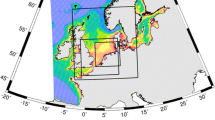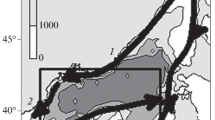Abstract
We used satellite altimetry data to investigate the Kuroshio Current because of the higher resolution and wider range of observations. In previous studies, satellite absolute geostrophic velocities were used to study the spatio-temporal variability of the sea surface velocity field along the current, and extraction methods were employed to detect the Kuroshio axes and paths. However, sea surface absolute geostrophic velocity estimated from absolute dynamic topography should be regarded as the geostrophic component of the actual surface velocity, which cannot represent a sea surface current accurately. In this study, mathematical verification between the climatic absolute geostrophic and bin-averaged drifting buoy velocity was established and then adopted to correct the satellite absolute geostrophic velocities. There were some differences in the characteristics between satellite geostrophic and drifting buoy velocities. As a result, the corrected satellite absolute geostrophic velocities were used to detect the Kuroshio axis and path based on a principal-component detection scheme. The results showed that the detection of the Kuroshio axes and paths from corrected absolute geostrophic velocities performed better than those from satellite absolute geostrophic velocities and surface current estimations. The corrected satellite absolute geostrophic velocity may therefore contribute to more precise day-to-day detection of the Kuroshio Current axis and path.
Similar content being viewed by others
References
Ambe D, Imawaki S, Uchida H, et al. 2004. Estimating the Kuroshio Axis South of Japan using combination of satellite altimetry and drifting buoys. Journal of Oceanography, 60(2): 375–382, doi: https://doi.org/10.1023/B:JOCE.0000038343.31468.fe
Arbic B K, Scott R B, Chelton D B, et al. 2012. Effects of stencil width on surface ocean geostrophic velocity and vorticity estimation from gridded satellite altimeter data. Journal of Geophysical Research: Oceans, 117(C3): C03029, doi: https://doi.org/10.1029/2011JC007367
CNES. 2016. SSALTO/DUACS User Handbook: (M)SLA and (M)ADT Near-Real Time and Delayed Time Products. CLS-DOS-NT-06-034
Hu Xiaomin, Xiong Xuejun, Qiao Fangli, et al. 2008. Surface current field and seasonal variability in the Kuroshio and adjacent regions derived from satellite-tracked drifter data. Acta Oceanologica Sinica, 27(3): 11–29
Hui Zhenli, Xu Yongsheng. 2016. The impact of wave-induced Coriolis-Stokes forcing on satellite-derived ocean surface currents. Journal of Geophysical Research: Oceans, 121(1): 410–426, doi: https://doi.org/10.1002/2015JC011082
Imawaki S, Gotoh M, Yoritaka H, et al. 1996. Detecting fluctuations of the Kuroshio axis south of Japan using TOPEX/POSEIDON altimeter data. Journal of Oceanography, 52(1): 69–92, doi: https://doi.org/10.1007/BF02236533
Ishikawa Y, Awaji T, Akimoto K. 1997. Global surface circulation and its kinetic energy distribution derived from drifting buoys. Journal of Oceanography, 53(5): 489–516
Lagerloef G S E, Mitchum G T, Lukas R B, et al. 1999. Tropical Pacific near-surface currents estimated from altimeter, wind, and drifter data. Journal of Geophysical Research: Oceans, 104(C10): 23313–23326, doi: https://doi.org/10.1029/1999JC900197
Liu Zhiqiang, Gan Jianping. 2012. Variability of the Kuroshio in the East China Sea derived from satellite altimetry data. Deep Sea Research Part I: Oceanographic Research Papers, 2012, 59: 25–36
Matsuno T, Lee J S, Yanao S. 2009. The Kuroshio exchange with the South and East China Seas. Ocean Science, 5: 303–312, doi: https://doi.org/10.5194/os-5-303-2009
Miyazawa Y, Kagimoto T, Guo X Y, et al. 2008. The Kuroshio large meander formation in 2004 analyzed by an eddy-resolving ocean forecast system. Journal of Geophysical Research: Oceans, 113(C10): C10015, doi: https://doi.org/10.1029/2007JC004226
Philipps O M. 1977. The Dynamics of the Upper Ocean. Cambridge, UK: Cambridge University Press
Qiu Bo. 2001. Kuroshio and Oyashio currents. In: Steele J H, Turekian KK, eds. Encyclopedia of Ocean Sciences. New York: Elsevier, 1413–1425
Teague W J, Jacobs G A, Ko D S, et al. 2003. Connectivity of the Taiwan, Cheju, and Korea straits. Continental Shelf Research, 23(1): 63–77, doi: https://doi.org/10.1016/S0278-4343(02)00150-4
Uchida H, Imawaki S. 2003. Eulerian mean surface velocity field derived by combining drifter and satellite altimeter data. Geophysical Research Letters, 30(5): 1229, doi: https://doi.org/10.1029/2002GL016445
Wu Kejian, Liu Bin. 2008. Stokes drift-induced and direct wind energy inputs into the Ekman layer within the Antarctic Circumpolar Current. Journal of Geophysical Research: Oceans, 113(C10): C10002, doi: https://doi.org/10.1029/2007JC004579
Acknowledgements
We thank the anonymous reviewers for their careful reviews and constructive comments in improving the original manuscript, and the editors who kindly polished this article with great effort. The merged AGV remote sensing data were provided by CMEMS, and can be downloaded from ftp://ftp.aviso.altimetry.fr/. The QuikSCAT wind data were processed and distributed by the Centre ERS d’Archivage et de Traitement (CERSAT) and can be downloaded from ftp://ftp.ifremer.fr/ifre-mer/cersat/products/gridded/MWF/L3/QuikSCAT/Daily. The Interim surface wave data sets can be downloaded from the ECMWF link: http://apps.ecmwf.int/datasets/data/interim-full-daily/. The GIS data of the streamlines from the Hydrographic and Oceanographic Department of Japan can be downloaded from http://wwwl.kaiho.mlit.go.jp/KANKYO/KAIYO/qboc/kur-osio-num.html. We also thank Kara Bogus, from Liwen Bianji, Edanz Editing China (http://www.liwenbianji.cn/ac), for editing the English text of a draft of this manuscript.
Author information
Authors and Affiliations
Corresponding author
Additional information
Foundation item: The National Science and Technology Major Project of the Ministry of Science and Technology of China under contract No. 2018YFF01014100; the National Programme on Global Change and Air-Sea Interaction under contract No. GASI-IPOVAI-01-05; the NSFC-Shandong Joint Fund for Marine Science Research Centers under contract No. U1606405.
Rights and permissions
About this article
Cite this article
Zhuang, Z., Hui, Z., Yang, G. et al. Principal-component estimates of the Kuroshio Current axis and path based on the mathematical verification between satellite altimeter and drifting buoy data. Acta Oceanol. Sin. 39, 14–24 (2020). https://doi.org/10.1007/s13131-019-1523-2
Received:
Accepted:
Published:
Issue Date:
DOI: https://doi.org/10.1007/s13131-019-1523-2




